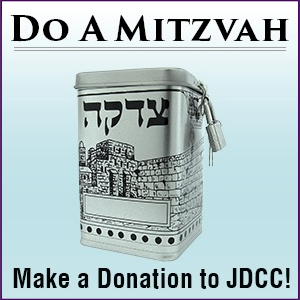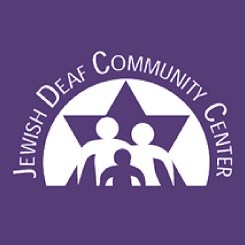I cannot believe its been two months since I last wrote. Thank you to Ira Rothenberg and EJ Cohen for responding to my last column. See their responses, right side.
This month I have a few miscellaneous thoughts to share with you.
How many of you subscribe to the Jewish-Deaf List? It is a wonderful e-mail chat group. They have been debating a number of “hot topics” related to Jewish interpreting. Contact me for information about how to join.
It is a continuing dilemma about where interpreters should stand. Many rabbis are reluctant to put the interpreter up on the bimah (stage). Either they feel it will be too crowded with all the people coming up and down the stairs OR they don’t see the need for everyone to see the interpreter, when only a handful of people are relying on him/her. I am sure there are also a few rabbis who are concerned that the interpreter will be “distracting”. In every situation where I have interpreted up on the bimah, I have gotten only positive comments from the members of the congregation. Everyone agrees that it enhances their worship experience to see prayer come alive in a visual way.
When I accept a secular interpreting job, I always work with another interpreter, if the job is more than two hours long. We take turns every 20 to 30 minutes. However, when I accept a Jewish interpreting job, I always seem to work alone. Most Reform shabbat evening or morning services are less than two hours, which is within my energy limitations. However, several times a year, I find myself interpreting a Conservative Bar/Bat Mitzvah. The service will often last three hours or more. About 12 noon, I feel myself fading. Why don’t I ever think of working with a team mate. Would the family or synagogues be willing to pay DOUBLE, for two interpreters? How would we split the assignment – in 20 minute shifts? One person signing English, the other person the Hebrew? One person the preliminary and Shaharit service, the other person the Torah and Musaf service? And how much more preparation would be involved to synchronize two interpreters Jewish signing styles? So I am wondering if any of you have attended a service with more than one interpreter?
Til then, if you want to contact me, you can write to me, c/o JDCC via e-mail [email protected] – it will be forwarded to me.
RESPONSES TO INTERPRETER’S CORNER
Hi Lore, …read your article in the May/June issue of JDCC News… I’m a 4th generation, native signer myself so I prefer ASL or PSE over SEE. If there’s no standard sign, I’d prefer to spell it out. I myself am not too crazy for initialized signs, meaning signing with a “lettered” handshape.
I always spell “Moses” but your sign “M” like commandments or law is acceptable. I agree BIBLE is a tricky sign – I prefer to use the sign TORAH but I understand your dilemma in choosing an appropriate sign for TANACH. How about the sign for “special book” or “honest book”?
I do not subscribe to the belief of Messiah because I was never raised on that concept myself. But I see what you mean about Christian tone behind HEAVEN. How about “wonderful place” or “peaceful place” (or substitute “land” for “place”) since you explained in the article that all people will rise from the grave on earth.
I go to Temple Beth Solomon for the Deaf in L.A. and saw their own versions of signs like HOLY, SIN, etc. You may want to ask Elaine Aikins (her daughter is an interpreter here Francine Stern) as she led the choir during high holidays for many years. She told us in the congregation that HOLY means SPECIAL and SIN means MISS THE TARGET (like “off the point”).
Good luck with your work. Hope these help.
Ira Rothenberg – North Hollywood, CA
Hi Lore!
I wanted to reply to your column in the JDCC newsletter. I’ve been signing MOSES differently than how you described, the “M” on the hand like “LAW” is what we use for MITZVAH, since we follow the meaning of COMMANDMENT, so for MOSES, we make M in a circle, like MONDAY.
For ABRAHAM, we sign A in one hand being caught by the other hand (to represent the angel stopping Abraham from sacrificing Isaac. For ISAAC, we sign I in the neck…signifiying where he might been sacrificed. (both of those are in Adele Shuart’s book) [Signs in Judaism].
Mark Farr came up with a sign for AARON, since his [Bar Mitzvah] Torah portion mentions him… after we discussed who Aaron was, he decided to spell AARON and then do the symbol for HIGH PRIEST, like the star trek/vulcan “LIVE LONG AND PROSPER” which, by the way, was used after Leonard Nimoy was told to come up with a symbol… and since HIS father was a Rabbi, he decided to use that. So it was the Jewish way prior to the vulcan way. For HOLY, we sign SPECIAL and then the H+clean, combining all the meanings. We’ve been told by the Deaf non-Jews that it’s been impressive to see the concept so clearly.
A major thing we’ve changed is that we no longer sign BLESS when we see BARUCH. In chatting with various Rabbis at CAJE [Conference of Alternatives of Jewish Education] conventions, I was told that we never are supposeded to bless G-d, and the way it is pronounced in English is not blessed, meaning past (blest) but bless-ed, meaning praise, so we sign G-D+ THANK+ PRAISE (I think Doug Goldhamer does that but we do it with less sound while clapping/praising.
I’ve put together a video called YAD B’YAD WITH EJ which has the SHEMA, OSEH SHALOM, CANDLE BLESSING, MOTZI, KIDDUSH AND THE ALEF-BET. It comes with a study guide, which explains the signs I’ve chosen and as a result , I’m in the process of making a second ediction, with different brachot. So far, I’ve sold 175 of the first one, and several Temples around the country are using it to help teach the choirs, etc.
EJ Cohen – Fremont, CA



